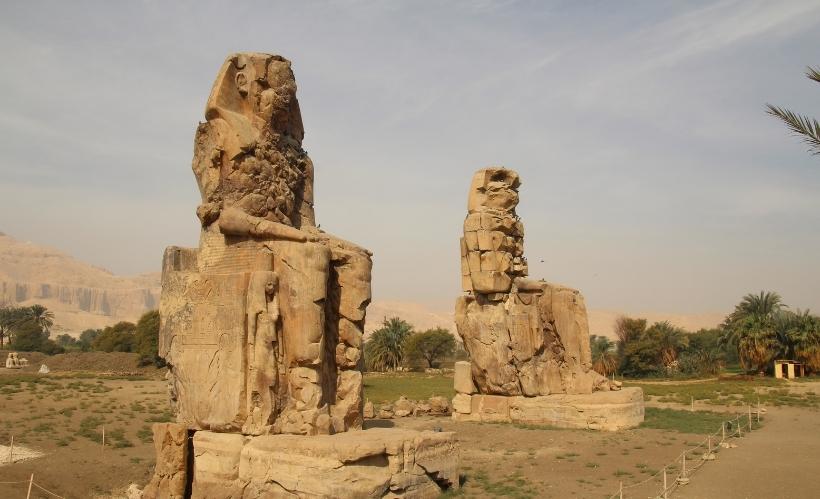Cultural, historical, adventure, and custom customized trips are just a few of the tours that Deluxe trips offer in Egypt and Jordan.

Among the numerous ancient Egyptian wonders, there are few other monuments that stir one's imagination as forcefully as the Colossi of Memnon in Luxor. Guarding the Theban plains along the west bank of the Nile River, the two colossal stone statues have stood sentinel over the landscape for more than 3,400 years. Steeped in history, mythology, and archaeological significance, the Colossi of Memnon remain one of the absolute must-see landmarks in Luxor, attracting travelers, historians, and spiritual seekers alike.
The Colossi of Memnon were constructed during the reign of Pharaoh Amenhotep III, who ruled Egypt in the 14th century BCE. These colossal statues were originally designed to flank the entrance of Amenhotep III’s mortuary temple, which was once the largest temple complex on the west bank of Luxor. So much of the temple was destroyed over the centuries by earthquakes and floods, but the statues stood—standing like the last remnants of an ancient great palace of the dead.
They are around 18 meters (60 feet) tall and were carved from a single block of quartzite sandstone, which is believed to have been transported from quarries near Cairo—an accomplishment considering the state of technology then.
The Greeks then named the statues "Memnon," long after the statues were built. They believed the statues represented Memnon, the heroic son of goddess Eos (Dawn) and king of Ethiopia, who had fought in the Trojan War. The connection was made based on one curious phenomenon.
It was said that the northern statue "sang" or made a musical note in the morning, particularly after an earthquake had opened cracks in the statue in 27 BCE. Travelers in ancient times thought the sound was Memnon calling to his mother, Eos. The "Vocal Memnon" attracted tourists in the Greco-Roman world, including emperors and scholars; even Emperor Hadrian was among them.
But the singing stopped after the statue was rebuilt in the 3rd century CE by the Romans—adding to its mystique.
Despite how time and nature have eroded most of their finer details, the statues retain masterful qualities of art. The statues are of Amenhotep III seated on thrones, hands resting on his knees, facing east to the rising sun. The sides of the thrones have carvings that are symbolic representations of Nile gods, uniting Upper and Lower Egypt, and inscriptions that previously commended the pharaoh.
The enormity and balance of the Colossi testify to the craftsman prowess of ancient Egypt. Standing at their side, one can't help but be awed by the heaviness of history and majesty of an empire from another day.
While the Colossi themselves are ruins, they are still a staple of Luxor's offerings to this day. Whether as an archaeology enthusiast, photographer, or merely a passing tourist, being at the feet of these giants is a humbling experience. Restoration projects are also visible in progress to uncover more of Amenhotep III's temple complex, with some columns and statues having been dug up in recent history.
In addition, the Colossi are beautifully situated on the west bank of Luxor close to other significant historical sites like:
Valley of the Kings – Location of Egypt's finest pharaohs' tombs.
Medinet Habu Temple – An incredibly well-preserved mortuary temple of Ramses III.
Karnak Temple (east bank) – The largest temple complex ever built.
The best time to explore the Colossi is during the cooler months from October to April. Visit in the early morning to enjoy soft lighting and fewer crowds—plus, you’ll be following in the footsteps of ancient visitors who came at dawn hoping to hear the statue sing.
No admission fee is required, and the statues are easily seen from the highway at road side or as an afterthought on a guided tour of the west bank of Luxo.
Bring a hat and sunscreen: There's not much shade at the site.
Hire a local guide: In your efforts to truly appreciate the history and the legends.
Spend a visit combined with the local sites such as the Valley of the Kings or the Temple of Hatshepsut as part of a day-long site-seeing.
The Colossi of Memnon are not just giant remains of the past but living histories carved into stone. They stand for the ancient Egyptian artistry, the Greco-Roman mythology, and the eternal human fascination with the divine and the colossal.
If you're traveling to Luxor, make sure that these guardians of stone are on your agenda. You're not just going to view two statues—you're going to feel a piece of eternity.
Discover now our answers to the most common questions that may come to your mind about tourism and trips to Egypt
Cultural, historical, adventure, and custom customized trips are just a few of the tours that Deluxe trips offer in Egypt and Jordan.
The Dead Sea, Petra in Jordan, the Pyramids of Giza, Luxor's historic temples, and many other famous sites can be expected to be explored with Deluxe Tours.
offer a hassle-free holiday, Deluxe Tours' packages generally include lodging, transport, meals, guided tours with experienced local experts, and entry fees to attractions.
Spring (March to May) and fall (September to November) offer the finest weather for sightseeing and outdoor activities, making those months the best times to visit Egypt and Jordan.
These two countries are close by, only a 1.5-hour flight apart, and when combined, offer a variety of distinctive experiences. We advise you to spend at least 12 days visiting both countries for a truly unforgettable experience
Combining the eclipse viewing with visits to historic sites like the Pyramids of Giza, the Valley of the Kings, and a Nile River cruise are highly recommended.
